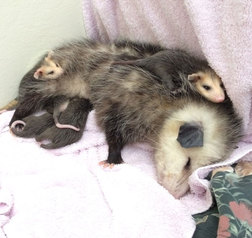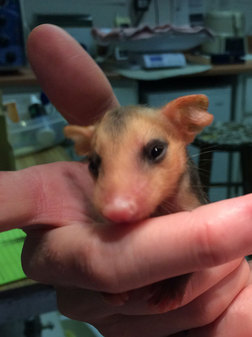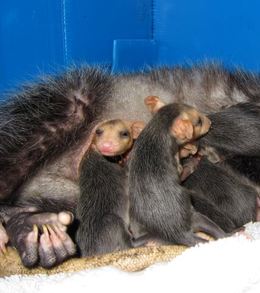WildCare's Wildlife Hospital treats nearly 4,000 ill, injured and orphaned wild animal patients from over 200 species every year. This is one family's story.

The Virginia Opossum is North America's only native marsupial. That means this interesting-looking and often misunderstood animal is a pouched mammal, like a kangaroo.
Many of us have seen opossums lumbering through our yards, or, more often, dead on the side of the road. But very few people have actually seen an opossum's pouch (called a marsupium) in action!
This mother opossum was brought to WildCare by a Marin Humane Society officer after she had been hit by a car. The car accident had severely damaged her left eye, but astonishingly, the nine (that's right, nine!) baby opossums in her marsupium were unharmed.

In fact, during the months between late February and November (even into December!), if you see an opossum dead on the side of the road, WildCare recommends stopping (only if it is safe to do so) and checking to see if the dead animal is a female with babies on board. Time is of the essence in this situation, but you may find yourself the rescuer of up to 13 baby opossums!
One caveat -- never try to remove the babies from the pouch; you must bring the mother's body to WildCare (or your local wildlife hospital). Because the babies are fused to the nipples, removing them can cause them injury.
Opossum patients #163 and #170 - 178
This mother opossum had survived the car accident, so we admitted her and her large family together.
An exam showed the ruptured eye to be the only injury, so the mother opossum was given pain medications while Medical Staff checked the babies for injuries. These babies were old enough to no longer be fused to their mother's nipples, so Medical Staff gently extricated them from the pouch to confirm that all nine had escaped the ordeal uninjured, and then placed them back inside.
With a clean bill of health for the nine little ones, the entire family was placed in a warm enclosure and given time to recover.
A visit to the veterinary ophthalmologist confirmed what Medical Staff had suspected -- that the mother opossum's eye, damaged in the accident, was beyond recovery, so it was removed. Fortunately, opossums rely primarily on their incredibly sensitive sense of smell to find food and navigate their environment, so the loss of the eye will not stop her from being released.
 Meanwhile, as you can see in the video above, the little opossums quickly started to outgrow their mother's marsupium. They were ready to start exploring the outside world!
Meanwhile, as you can see in the video above, the little opossums quickly started to outgrow their mother's marsupium. They were ready to start exploring the outside world!
Opossums have an interesting dispersal strategy for their young. Once the babies are old enough to start leaving the pouch, they stay attached to their mother's back with their incredibly clingy little paws while she patrols her territory. Eventually a baby will lose his grip and fall off, at which point he is on his own. If a baby opossum is at least the size of a softball from the tip of his nose to the base of his tail, he is old enough to survive on his own. A smaller baby opossum, however, should be brought to WildCare immediately.
Watch a mother opossum and her babies in an enclosure at WildCare in the video below. With so many little opossums sharing the space on her back, it's no wonder the little ones lose their grip!
While at WildCare, these nine baby opossums have reached the age at which they start exploring solid foods. To facilitate this, the babies are offered a tempting array of soft foods to encourage them to wean. By press time, all nine babies have discovered the joys of chopped fish, fluffy eggs and fruit yogurt (all mixed together, thank you very much!).
Watch one of the babies enjoying her dish of delicious treats in the video below:
WildCare is a 501(c)3 nonprofit organization supported almost entirely by private donations and individual memberships. Visit us online at wildcarebayarea.org.

